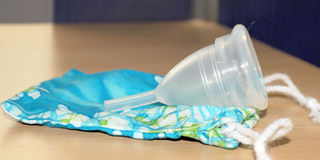Menstrual cup: Another way to manage that time of the month

A menstrual cap can be used and reused when needed, for up to six years, so it comes with a pouch where it can be kept for future use. Photo by Faiswal Kasirye
What you need to know:
Menstruation is a natural process that a woman’s body goes through monthly. Though any woman is prepared to deal with it when it comes, it can be uncomfortable when dealing with the flow. This is one of the innovations to manage menstruation comfortably.
Menstrual periods can be messy time, so a lot of thinking and research is being put in to make the days as normal as possible. As such, various kinds of sanitary material have been made: there are disposable pads, reusable pads, cotton pads, tampon, among many others. Add to ths list, menstrual cup, also known as the moon cup.
In Uganda, the menstrual cup which has only but recently been introduced on the market is the latest addition to the table of alternatives that women can use to take care of themselves during their menstrual periods. It is not so available on the local market that a couple of gynaecologists in the country that we talked to were not familiar with it.
Its form
The menstrual cup takes the form of a funnel when held upwards and of a bell when held upside down. It is made of non-latex medical-grade silicone so it feels like hard but flexible rubber. It is in two sizes: small and big. The small one is recommended for women that have never had a normal birth and the big one for women that have had a normal birth.
How it works
Unlike sanitary towels, pads and tampons that work in a way that they absorb the menstrual flow, the cup like the name suggests, collects the fluids.
It holds up to 30ml and most women, according to Dr Mike Kagawa, a gynaecologist at Mulago Hospital, can produce between 60ml and 80ml during their periods. On average, menstruation periods last four days which comes to about 16ml of flow daily.
Hygiene
Like with any other sanitary ware, the key point when using the cup is good hygiene to avoid infection. Dr Romano Byaruhanga, a gynaecologist at Nsambya Hospital, says, it is personal property and not to be shared. Before use, wash hands thoroughly and make sure the cup is clean.
It is recommended that you wash the cup with non-medicated soap (dish-washing soap) and hot water (not boiling water). “Anything else like powdered and liquid detergent or any other solution that is stronger than dish washing soap is not to be used,” Dr Byaruhanga warns.
Because of the cleaning procedure, Liz, 35, a reproductive health expert, does not empty the cup until she is at home. “I fear emptying it from the office washrooms first because to clean it, I need very hot water which we don’t have in our washrooms. Secondly, since I don’t clean the bathroom myself, I am not sure about its cleanliness in case I forget and touch the sink and then the cup. So, I would rather wait and do it from home.”
The cup should be changed every 12 hours which is less than the time an average employee spends at work. The doctor adds, “When you remove it, wash it thoroughly and air dry before re-inserting it. And when your month’s cycle is done, after washing and air drying it, place it in the fabric bag it comes in before keeping it away.”
A few women’s experiences
When it comes to usage, Liz who has used the cup for years now says, it is a learning process for everyone and one will learn to use the cup properly after using it during a couple of cycles. She says it is hard to get it right the first time and might also be a little uncomfortable because you are conscious of it. But with time, it becomes comfortable and you will even forget that you are wearing one.
Muriuki, 24, testifies, “The first time I used it, it felt weird but I managed to drift off [to sleep] when I went to bed. Three hours later when I woke up it had leaked. The cup was full and that is probably why it leaked. But ideally, it is not supposed to leak even when full. After emptying and cleaning it, I put it right back and it was really uncomfortable.”
It was also a struggle to remove it and it hurt a bit. Eventually, it came off and she tried it again another day. The third time, it worked perfectly all day long. “In fact, I forgot about it. There was no leakage, discomfort and it didn’t hurt when I was removing it,” she recalls.
Yet for Jane, 21, a student, day one was smooth but on day two the stem kept scratching her. She trimmed the stem as it is advised if it turns out to be a little long and it was comfortable thereafter. However, it hurt when removing it. “After a few trials I learnt that position matters when inserting and removing the cup. And what I like most about the cup is that I don’t have to worry about where and how to dispose it,” she says.
Merits and demerits
The menstrual cup is re-usable, eco-friendly and cost-effective as it can be used for up to six years. “It is also more convenient since you may not have to empty it as many times as you would change a pad or tampon. It is also the best alternative for women who are sensitive because the cup is made of silicone which causes less reaction when placed on the body,” Dr Byaruhanga says.
However, it is a little more time-consuming when inserting and using it. It also takes a while to learn how to insert and remove it efficiently. But once you master how to use one, you can swim, jump, dance, sleep and ease yourself without worrying about menstrual flow.




